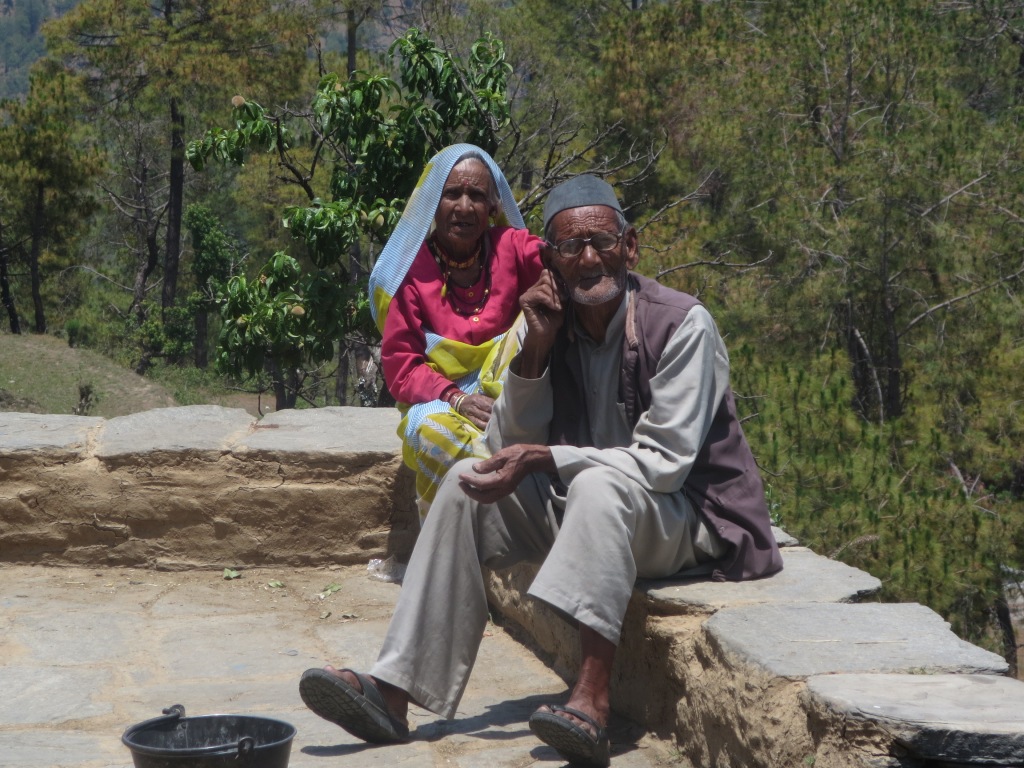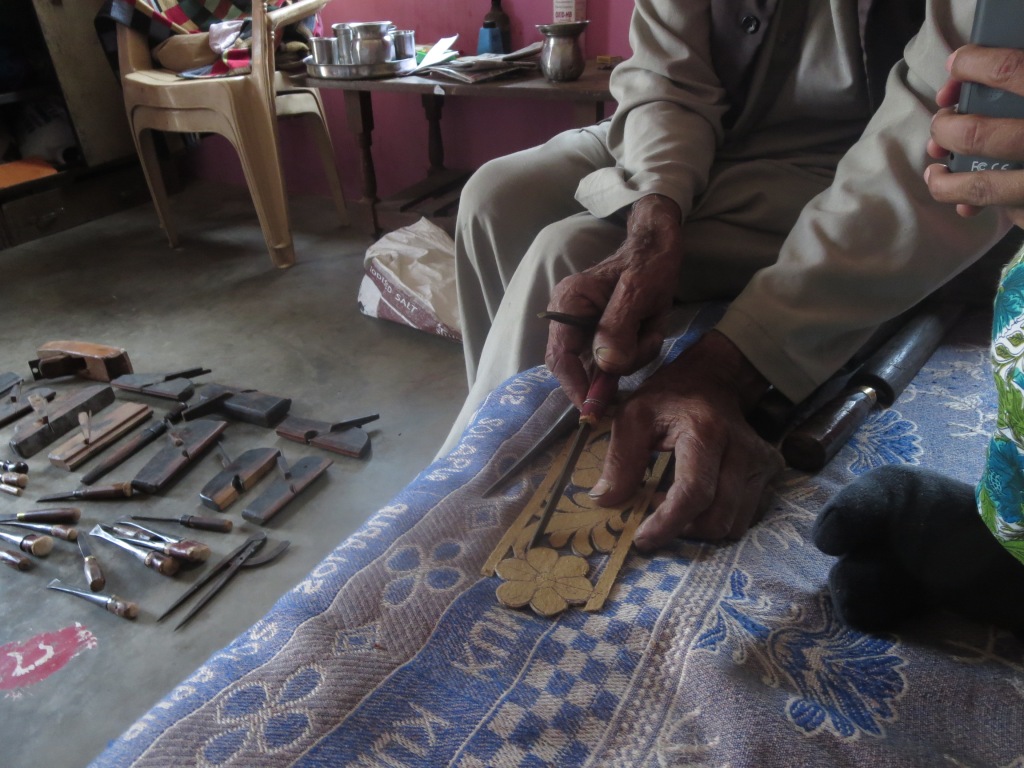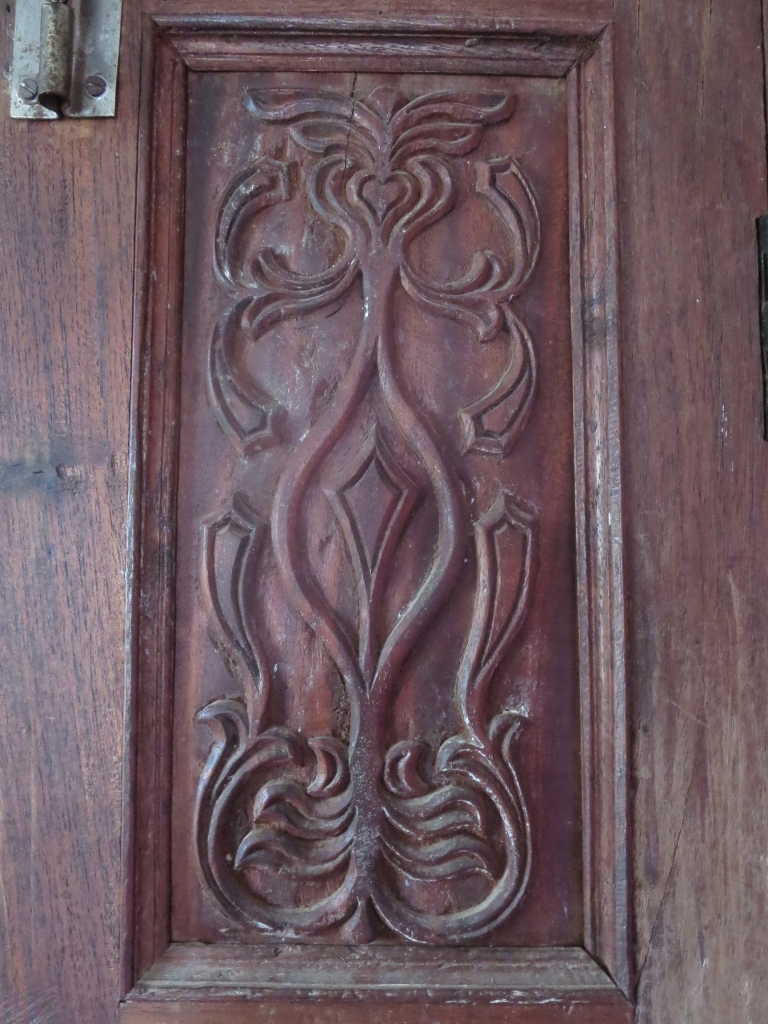
I see the dreams of Gangaramji many days before I actually meet him. Though I don’t yet know that these are his dreams when I look at the intricate wood carvings on the doors and windows of my friend’s house on top of a hill in Satoli, Uttarakhand. I don’t yet know his name, but the elaborately carved doors and window frames fascinate me. When I visit Aarohi, the NGO founded by my friend, Sushil Sharma, I notice the same kind of wood-carved pillars in the building. I soon learn that these are done by Gangaramji, one of the last Likhai artists in the region. I also hear he is frail and old and has had no students; with him, people tell me grimly, this art of woodcarving would die.
As a kid I had travelled with my parents in Garhwal region on the lap of the Himalayas. I recall seeing intricately carved doors and windows on the houses we passed but I did not know what this craft was called. It turned out that Oona, Sushil’s late wife and co-founder of Aarohi had documented the practice of Likhai in the area soon after their NGO began functioning in 1992. The documentation is impressive, it includes photographs and research on the wood used, details about the Forest Laws that had placed restrictions on procurement of raw material, the motifs used and case studies of artisans. Gangaramji is one of the artisans who Oona had spoken to. In her documentation, the two artisans she had spoken to both felt the art of Likhai was slowly dying and the only way it might survive them would be to have a training school that taught this craft and popularised it among the youth of the region. Oona’s report correctly pointed to the link between the complexities of transit laws that related to the cutting down of trees inside forests and outside. The colonial economic policies were framed to make the British the sole benefactors of India’s timber resources. The complex transit permits were introduced by the Indian Forest Act of 1878 and retained in the Forest Act of 1927. The Forest Conservation Act which was formulated more than three decades after Indian Independence swerved towards conservation, did not make it easier for Likhai artists to procure the right kind of wood for their craft. The lack of the right raw material was one of the obvious reasons for the craft to perish.

But was that the only reason for this craft to be faced with imminent extinction? Why were there no craftsmen learning this art? And if the traditional arts in societies like India which had come late into industrialisation, were family-based, why had this craft not been passed on to the children of the artisan? Oona had talked extensively to the Likhai craftsmen, and yet the documentation did not include any oral history resources. Encouraged by Sushil and Sheeba Sen (who was then part of Aarohi), I decide to undertake a journey to Gangaramji’s village to interview him. Like most oral historians, I rarely travel without my audio recorder. For haven’t we all experienced the serendipity of stumbling across somebody whose compelling life story was waiting to be recorded?
Diyari, Gangaramji’s village was not close and communication was erratic. It took a couple of days for the NGO to reach out to the aged and frail Gangaramji to ask if he is willing to indulge me. Once we heard from him, I started out for his village with Nikhila Nanduri, one of my undergraduate students from Bangalore, who happened to be interning with Aarohi. The car dropped us off at the foot of a hill; the driver explained that though this would be a longer walk it was less arduous. But even this climb that involved walking up a steep gradient and crossing a hill was not easy for someone unused to mountainous terrains. As we reach the top of the first hill we encounter Gangaramji. He looks as ancient as the hills and as gentle; his smile reflecting the warmth of the sunny day. He clasps his cane in his gnarled, arthritic hands as he raises them in greeting. “Namaste”. He was waiting to walk us downhill to a tea stall on the main road. He is hesitant to take us home, as he thinks we townsfolk would appreciate the tea at the shop better. “But we would like to see your tools,” I say. That is all it takes to convince him to change his mind.

We follow him up another hill to his home. After he has made us sit inside, he hauls his sack of tools into the room and begins laying them out with great care. The interview does not begin in the usual manner, he begins by talking about the aches and pains he has – in his knees, his back and his hands. But soon he smiles with pride and says, “You know, the “English” tools that are available are not of much use to me, so I had my own tools made. Some of these tools are very old – my father would do the same work, no? Some tools are new – sometimes tools get lost then we have to get them made again.” So, we begin in media res, with Gangaramji speaking animatedly about his tools. Indeed, these tools seem an extension of his hands as he demonstrates how he uses the cardboard stencils to carve patterns on the wood.
“When did you begin learning this work?” I ask. I realise soon that it is not a question that he finds easy to answer. Not because he has forgotten, nor because the early years have receded from memory for this eighty-five-year-old, but because the craft tradition, which had once been part of his everyday life was fast disappearing. That fact looms large before him. For him there is no specific point of beginning. “This was a pratha – a tradition, earlier.” He grew up with it.
Gangaramji was thirteen when he began learning the craft of Likhai. The process of learning a craft is complicated as Richard Sennett reminds us: “The apprentice is often expected to absorb the master’s lesson by osmosis; the master’s demonstration shows an act successfully performed, and the apprentice has to figure out what turned the key in the lock.” Despite belonging to a family of craftsmen, Gangaramji did not learn from his father. His teacher, Nariram used to come to his house from his village in Behruli and master and student would work together all day, sitting in close proximity and working on different parts of a piece of wood. One cannot learn without a “Master – a guru – just as you have a master who teaches you to read and write in school.” He explains. Gangaramji learnt from his teacher the use of right tools – tools must be appropriate for the design you wish to carve. After five years of apprenticeship, in 1946, Gangaramji began working on his own. He tells me that his guru, Nariram had later looked at his work and said that though he had taught him, Gangaram could now become his guru! A compliment that still makes him chuckle with pleasure. “I learnt with five tools but created a hundred and fifty tools – perhaps, that is why he said this to me.” The creation of a range of new tools was perhaps Gangaramji’s way of responding to the challenge of working with inadequate tools, as Sennett points out, lessons are ingrained in “the very incompleteness of the tool”.
Curious about the making of these beautiful patterns I wondered if Likhai has set conventions of design? Gangaramji smiles and says he imagines the designs in his mind – in fact, the designs appeared in his dreams whenever he was making a door or a pillar. I can recognise a pinecone here and a lotus there. “These are things I think up,” He tells me. He first draws out some of the intricate patterns on paper and translates them on to wood – enlarging them if the design calls for it. Doors and pillars carved by him have travelled far and wide. He has made pillars, doors and windows for “the doctor’s house” in Satoli – as he refers to my friend, Sushil; some of the doors and pillars he has carved have travelled to Ranikhet nearby and far away Delhi. At eighty-five, he no longer works on Likhai. “This work has stopped now.” And adds, “I am too worn out to continue.” Houses in the region no longer have these exquisitely carved doors – “plain” doors and windows is what everyone wants now. He worries that nobody will inherit his tools as nobody has really learnt from him. “I never became a guru” – he says this in a matter-of-fact way. “The young people now all want to be ‘heroes’ – they do not want to learn this craft.” His sons earn their living driving taxis in the hills – earning in the tourist season and struggling when the season ends. Later, Nikhila surprises me with her perceptive comment about Gangaramji’s lack of students – “Just as each pattern needs the right tool, every master needs the right student” – an insight that came to her as she watched him demonstrate his tools and one that stays with me. Perhaps Gangaramji never found the right students within his family or in the region. Though he tells us of one local student who has been coming to him to learn, he is uncertain about the depth and intensity of his interest, or its extent. But he recounts all this with no bitterness. He laughs as he tells me that one needs shaukh or passion to continue doing this work.
Gangaramji passed away quietly in 2018 – six years after I had interviewed him. His sole student never really learnt from him despite being encouraged by local NGOs, as Sheeba Sen (who has since founded Alaap) tells me. Gangaramji’s tools probably lie forgotten in some corner of his home or perhaps they have been put to other uses. I wonder what caused the death of Likhai as a craft in the region? Was it because the forest laws made the wood needed for Likhai so difficult to procure? Or because there were no governmental interventions that created craft schools and made the craft viable as a livelihood option? Or had Gangaramji’s Likhai doors travelled too far away – to cities where nobody knew or cared about their making? The death of a craft also alerts us to the fact that the dreams of the artisan die with him. The artefact that travels too far away, is no longer available to inspire local artists. When a craft form disappears, it ceases to be part of the everyday life of the community that once created it. Over time the memory of the artefact and the knowledge of how it was made fades too, with it wanes the ability of the hands to use the tools involved in their making, the capacity of the mind to grasp the challenges presented by old tools and the imagination and technical familiarity to invent new ones. The fragile artisanal community bereft of confidence struggles with new ways of putting together their lives, a task that leaves them too exhausted to dream up designs or create tools to translate their dreams on wood. I cannot help hoping though that one day, the doors, windows and cupboards Gangaramji has carved for his own home will re-ignite in the next generation a curiosity that inspires and awakens new dreams. Perhaps, many generations later, a young person will discover his sack of tools, begin tinkering with them and passionately embrace and re-invent this craft that the region was once known for. I can hear the old man’s chuckle as I write this down.
Indira Chowdhury

Acknowledgements:
I am grateful to Nikhila Nanduri for insightful discussions as well as her translation and interpretation of the interview into a thoughtful graphic form as also her reflections on the process. As always, I thank Vivek Dhareshwar for insightful conversations.
Sennett, Richard. The craftsman. Yale University Press, 2008.
Nikhila Nanduri, “Hills and Stones” in Orijit Sen and Vidyun Sabhaney (eds.), First Hand: Graphic Non-Fiction from India, Volume 1, Yoda Press, 2016.
Nikhila Nanduri, “Graphic narratives from the hills: a wood-carving tradition in Uttarakhand, India”, Oral History, Autumn 2018, 46, No.2 (2018), 97–108.







Hi Indira,
How are you? Gangaramji sounds interesting. It would be nice to see a photo of some of his work.
Love, Prim xxx
>
LikeLike
Hi Prim,
The wooden window that is carved is his work as also the four wooden panels carved with flowers, creepers and pine cones.
Thanks for reading.
Warmest,
Indira
LikeLike
Great tribute. Kudos for the hard work and bringing the light on things we need to nurture and preserve ..
LikeLike
Thank you Vinnie.
LikeLike
Dear Indira, another piece of superb and detailed storytelling. As I read I could see Gangaramji and his tools come live. It was also painful to know that with his demise this beautiful craft is no longer.
LikeLike
Thanks so much. What you now have are machine cut patterns on doors and windows. Pretty similar to the computer-generated block print designs on fabric.
LikeLike
इंदिरा जी बहुत-बहुत धन्यवाद इस अद्भुत लेख को हम तक पहुंचने के लिए ,
उत्सुक हू की अगर कुछ और जानकारी उनके और उनकी पीढ़ी के बारे में दे पाए !
क्या आपके पास कोई जानकारी है कि यह पारंपरिक कला और काम अभी भी उनकी पीढ़ी द्वारा चल रहा है?
LikeLike
Thank you, Ashishji. You could contact Aarohi – http://www.aarohi.org. But as I say in my post, the younger generation in his family do not undertake this work.
LikeLike